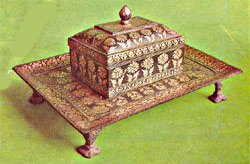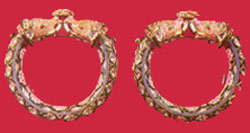
The Museum has in its collection about 1300 items of decorative an. These include jades, jewelleries, metal crafts, glass wares, ivory , weapons and so on. These are mostly related to objects of daily use and are skillfully and artstically worked out. The objects of decorative an in this collection span a period roughly between the 17th and 20th century covering the periods of the grand Mughals, provincial Mughals, Company and beyond. The Mughals, once settled, led a luxurious life and the sophistication of their taste was noticed in objects of their daily use. Theirinterest in the decorative an is seen from the the time of Emperor Akbar (1556-1605) and it gained Momentum during the periods of Jahangir (1605- 1627 ) and
Shah Jahan (1628-1658). Royal workshops to produce objects of decorative ars were set up in Agra, Fatehpur Sikri, Delhi, Lahore and Ahmedabad. Skilled craftsmen from within and outside the country were commissioned who were called Mughal an and its reverberations are felt even today.
From the writings of contemporary chroniclers some interesting information are available, particularly about the emperors and their personal interests in different types of craft and craftsmen. Royal titles such as Nadir- ul-zaman (wonder of the realm), Nadir-ul-Asr (Wonder , of the age), Hunarmand (the skilled one) were conferred upon outstanding artists and craftsmen. The Mughals observed a number ofceremonies throughout the year


during which they presented gifts and also appreciated , the 'artistic items given to them. Courtiers, diplomatic envoys, traders and merchants were in constant search of rare, unique and tasteful gifts which could be given to the emperor to get the royal favor .
Metalware: A significant feature of decorative art was the fashioning metal wares in different kinds and forms. One of these, is called as Bidri ware. The term owes its origin from the name of place of its manufacture

Brass was also in use for making utensils both for religious and secular needs. The so called Ganga- Jamuni wares (combination of brass and copper) of Banaras, theSwami works of Madras (Chennai) are quite popular. Among the brass works in the collection of this Museum, is a unique and rare astrolabe (an instrument for calculating astronomical equations). This astrolabe was made in 1660 AD, by artist Md, Mehundi Isphahanl and was dedicated Moharnmad Badi, the ruler of Balkh (displayed in the Nidhi gallery). The collection includes two more Indian astrolabes made in brass. The kings used to set out for war or hunting or for navigation after calculating the right and auspicious time with the help of astrolabes,
Glassware: Utensils made in glass were also in high demand during the Mughal period, Initially, glass utensils were brought either from Europe or neighbouring country exported from I,ndia. Fire arms were exclusive] of Persia, The glass items were included in the gifts for Mughal emperor from the courtiers, diplomats and the traders, Soon, a craze developed in India for glass items and such items were considered as coveted items for collection, Contemplating the present and future demands , , of glass objects, the Dutch, the English and the Roman (Venetian) glass factories fabricated glasses with Indian shapes and mannerisms and these were called 'Indianate', The glass utensils included coloured rose water sprinklers (Gulab-pash), hukka base, chilam-posh (tobacco and fire " container), cups, plates, dices, mirror back, etc. and such specimes are on show. The glasses manufactured at Kapadwanj (Gujrat), Alwar (Rajasthan) and Patna (Bihar) were of inferior quality and these could not rise to the parallel standard of European examples.
Arms: The Museum also has representative collection of arms and armoury. This includes -bows, arrows, archer's rings, spears, mace, battle axe, swords, daggers, fire arms and the protective armours such as shields, helmets and coat of mail (displayed) and these are dated between 16th and lOth century A.D. The collection has some punch-dagger (Jamdhar), the short blade swords (Khadga), swords with curved blade (Shamsheer). The last item was introduced into India from Persia. High quality of damascened or watered steel was used for manufacturing the blade of these swords, the raw iron was, however, exported from India. Fire arms were exclusively made in European techniques. The surface decorations of some of these weapons gave them a jewel-like appearance. Lavish use of gold, silver and precious stones are noticed on the hilts, blades and scabbard and such items became prized possessions of their owners.